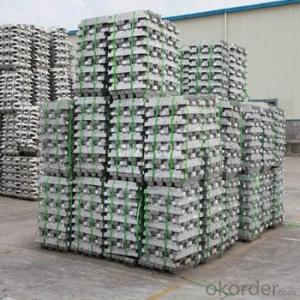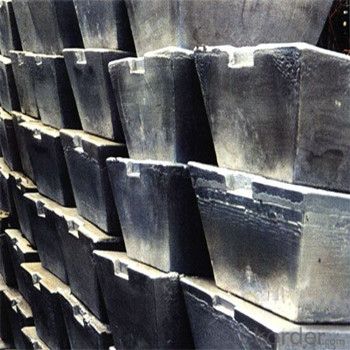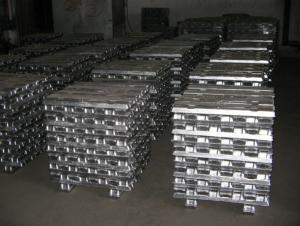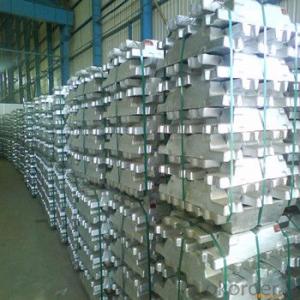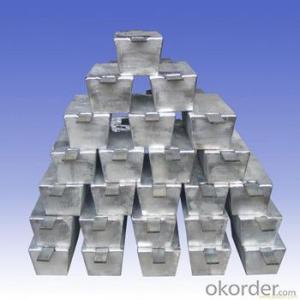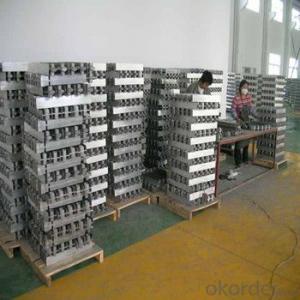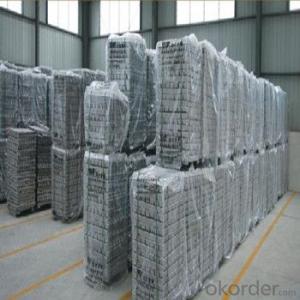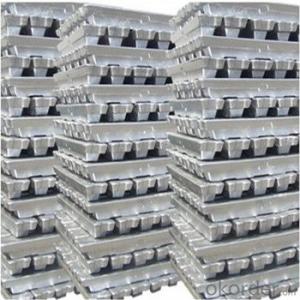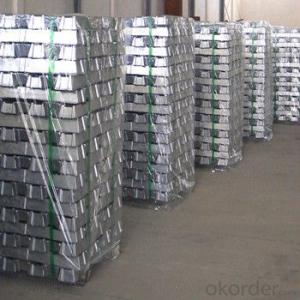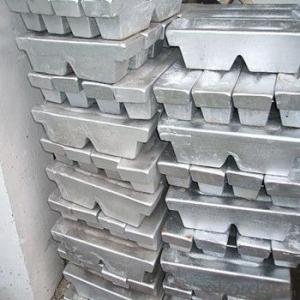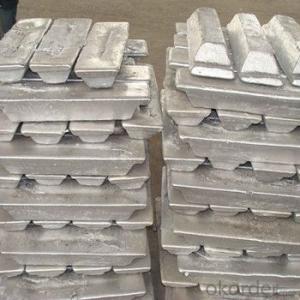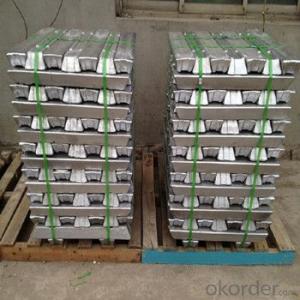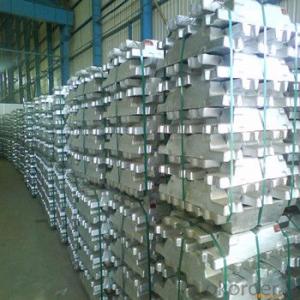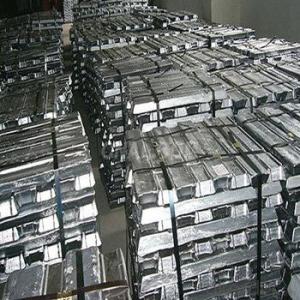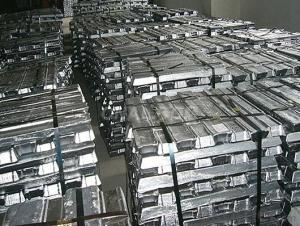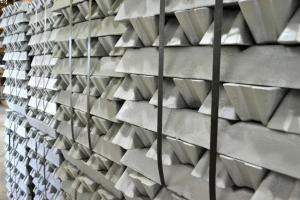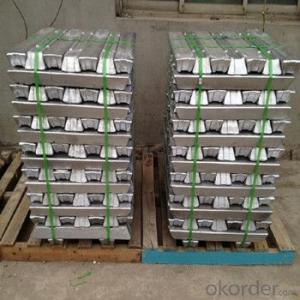Aluminum Ingot 99.7% Hot Selling With Best Price
- Loading Port:
- China main port
- Payment Terms:
- TT OR LC
- Min Order Qty:
- 1000 m.t
- Supply Capability:
- 10000 m.t/month
OKorder Service Pledge
OKorder Financial Service
You Might Also Like
Pure Aluminum Ingot Used for Industry
1.Structure of Aluminum Ingot Description
An ingot is a piece of material, usually metal, that is cast into a shape suitable for further processing. Insteelmaking, it is the first step among semi-finished casting products. Ingots usually require a second procedure of shaping, such as cold/hot working, cutting, or milling to produce a useful final product. Non-metallic and semiconductor materials prepared in bulk form may also be referred to as ingots, particularly when cast by mold based methods.
2.Main Features of the Aluminum Ingot
•High Purity
•High strength
•Fast melting
•Best price
•Good after-service
3. Aluminum Ingot Images
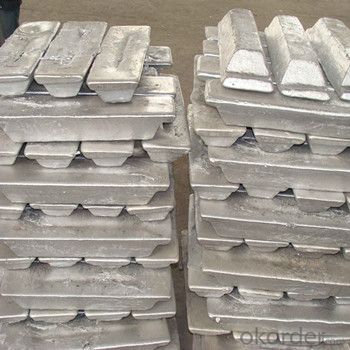
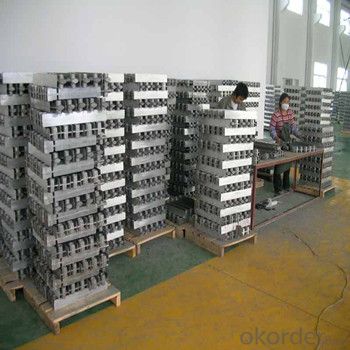
4. Aluminum Ingot Specification
Grade | Chemical Composition % | |||||||||
Al≥ | impurities ≤ | |||||||||
Si | Fe | Cu | Ga | Mg | Zn | Mn | others | Sum | ||
Al99.9 | 99.90 | 0.50 | 0.07 | 0.005 | 0.02 | 0.01 | 0.025 | - | 0.010 | 0.10 |
Al99.85 | 99.85 | 0.80 | 0.12 | 0.005 | 0.03 | 0.02 | 0.030 | - | 0.015 | 0.15 |
Al99.7 | 99.70 | 0.10 | 0.20 | 0.010 | 0.03 | 0.02 | 0.030 | - | 0.030 | 0.30 |
Al99.6 | 99.60 | 0.16 | 0.25 | 0.010 | 0.03 | 0.03 | 0.030 | - | 0.030 | 0.40 |
Al99.5 | 99.50 | 0.22 | 0.30 | 0.020 | 0.03 | 0.05 | 0.050 | - | 0.030 | 0.50 |
Al99.00 | 99.00 | 0.42 | 0.50 | 0.020 | 0.03 | 0.05 | 0.050 | - | 0.050 | 1.00 |
5.FAQ of Aluminum Ingot
We have organized several common questions for our clients,may help you sincerely:
①How about your company?
A world class manufacturer & supplier of castings forging in carbon steel and alloy steel,is one of the large-scale professional investment casting production bases in China,consisting of both casting foundry forging and machining factory. Annually more than 8000 tons Precision casting and forging parts are exported to markets in Europe,America and Japan. OEM casting and forging service available according to customer’s requirements.
②How to guarantee the quality of the products?
We have established the international advanced quality management system,every link from raw material to final product we have strict quality test;We resolutely put an end to unqualified products flowing into the market. At the same time, we will provide necessary follow-up service assurance.
③How long can we receive the product after purchase?
In the purchase of product within three working days, We will arrange the factory delivery as soon as possible. The pecific time of receiving is related to the state and position of customers.Commonly 7 to 10 working days can be served.
- Q: How are aluminum ingots used in the production of beverage cans?
- Aluminum ingots play a crucial role in the production of beverage cans. These ingots are first melted down and then cast into large blocks, which are further rolled into thin sheets of aluminum. These sheets are then cut into smaller pieces, which are used as the main body of the beverage can. The aluminum sheets are shaped into cylindrical forms and then welded together to create the can body. The top and bottom of the can are then added, which are typically made from a different type of aluminum alloy. The can is then coated with a protective layer to prevent corrosion and to maintain the taste and quality of the beverage. The use of aluminum ingots in the production of beverage cans offers several advantages. Aluminum is lightweight, making it easy to transport and stack cans. It is also a highly malleable material, allowing for intricate shaping and design possibilities. Additionally, aluminum is resistant to corrosion, ensuring the longevity of the cans and the preservation of the beverage inside. Furthermore, aluminum is a sustainable and recyclable material. The use of recycled aluminum in the production of beverage cans significantly reduces the energy consumption and environmental impact compared to using virgin aluminum. This makes aluminum cans one of the most environmentally friendly packaging solutions available. In conclusion, aluminum ingots are essential in the production of beverage cans. They are melted down, rolled into sheets, and shaped into the main body of the can. Aluminum's lightweight, malleability, corrosion resistance, and recyclability make it an ideal material for beverage cans, offering convenience, durability, and environmental benefits.
- Q: What is the role of aluminum ingots in the production of aircraft engines?
- Aluminum ingots are of utmost importance when it comes to manufacturing aircraft engines. This lightweight metal possesses exceptional strength, high thermal conductivity, and excellent corrosion resistance, which makes it an ideal material for various components in aircraft engines. One major application of aluminum ingots in aircraft engines is the production of engine casings. These casings serve as protective housing for internal engine components like the combustion chamber, turbine, and compressor. Thanks to aluminum's lightweight nature, the overall weight of the engine can be reduced, resulting in improved fuel efficiency and enhanced aircraft performance. Moreover, aluminum ingots are utilized in the manufacturing of engine components such as pistons, cylinder heads, and connecting rods. These parts require a combination of strength, durability, and heat dissipation properties, all of which can be provided by aluminum. By incorporating aluminum ingots into these components, engine manufacturers can achieve a balance between weight reduction and ensuring structural integrity. Furthermore, heat exchangers and cooling systems within aircraft engines are fabricated using aluminum ingots. These systems play a crucial role in regulating the temperature of various engine parts, ensuring optimal performance and preventing overheating. Aluminum's high thermal conductivity allows for efficient heat transfer, making it an excellent choice for these applications. In addition to its material properties, aluminum ingots are favored for their ease of processing and manufacturing. Aluminum can be cast, forged, extruded, and machined into intricate shapes and designs, enabling the production of engine components with precise specifications. Overall, aluminum ingots play an indispensable role in the production of aircraft engines. Their lightweight nature, strength, thermal conductivity, corrosion resistance, and ease of processing make them the preferred material for manufacturing engine casings, components, and cooling systems. By incorporating aluminum ingots into aircraft engine production, the overall performance, efficiency, and reliability of modern aircraft are significantly enhanced.
- Q: Now refining aluminum ingot profits? What are the main factories?
- In general, the main customers are made of raw materials for the recycled aluminum plant. The price depends mainly on the composition and physical quality. This equipment is like a house to buy equipment and then to their masonry, generally dug a hole 2 meters deep, the pot material has 2 kinds, one kind is graphite, a cast iron, graphite is relatively better, Zhejiang has Yongkang sell, including tools, and this process is originated in the then, if you want to do better to the study, to be able to please the master.
- Q: What is the average weight of an aluminum ingot?
- The average weight of an aluminum ingot varies depending on its size and shape. However, a common average weight for an aluminum ingot is around 25 to 30 pounds (11 to 14 kilograms).
- Q: What is the casting process for aluminum ingots?
- The casting process for aluminum ingots involves melting aluminum in a furnace and then pouring the molten metal into a pre-designed mold. Once the metal cools and solidifies inside the mold, it is removed and the ingot is ready for further processing or usage.
- Q: What are the main factors influencing the choice between aluminum ingots and aluminum forgings?
- The main factors influencing the choice between aluminum ingots and aluminum forgings include the desired strength and durability of the final product, the complexity of the desired shape, the required dimensions and tolerances, the anticipated production volume, and the available budget.
- Q: How are aluminum ingots used in the automotive industry?
- Aluminum ingots are used in the automotive industry primarily for the production of lightweight components, such as engine blocks, cylinder heads, and body panels. This helps to improve fuel efficiency and overall vehicle performance, while also reducing emissions. Additionally, aluminum ingots are utilized in the manufacturing of transmission cases, suspension systems, and other structural parts, contributing to the overall strength and durability of vehicles.
- Q: How are aluminum ingots used in the production of kitchen utensils?
- Aluminum ingots are used in the production of kitchen utensils as they are melted down and cast into molds to create the desired shape and structure of the utensils. The molten aluminum is poured into the molds, which are then cooled and solidified to form the utensils. This process allows for the production of lightweight, durable, and heat-conductive kitchen utensils that are commonly used in cooking and food preparation.
- Q: What are the limitations of using aluminum ingots in high-temperature applications?
- One limitation of using aluminum ingots in high-temperature applications is its relatively low melting point of around 660 degrees Celsius. This restricts its use in environments where temperatures exceed this threshold, as the ingots can melt and lose their structural integrity. Additionally, aluminum has a high coefficient of thermal expansion, which means it expands significantly when exposed to heat. This expansion can lead to dimensional instability and potential damage to the surrounding structures or components. Moreover, aluminum has lower strength and hardness compared to other metals like steel or titanium, which may make it less suitable for high-temperature applications that require superior mechanical properties.
- Q: How are aluminum ingots shaped into different forms?
- Aluminum ingots are shaped into different forms through a process called aluminum extrusion. This process involves heating the aluminum ingot until it reaches a molten state. The molten aluminum is then forced through a specifically designed die, which determines the shape and size of the final product. The die is a hollow profile with the desired shape, and it acts as a mold for the molten aluminum. Once the molten aluminum passes through the die, it undergoes a cooling process, which solidifies it into the desired shape. The cooling process can be done through various methods, including air cooling or water quenching. The method used depends on the specific requirements of the product. After the aluminum has cooled and solidified, it is then cut into the desired length. This can be done either during or after the extrusion process, depending on the complexity of the shape or the requirements of the product. Aluminum extrusion allows for a wide range of shapes to be produced, including solid profiles, hollow sections, tubes, and intricate designs. The process is highly versatile and efficient, making it a popular choice for shaping aluminum into different forms. Additionally, the lightweight and corrosion-resistant properties of aluminum make it an ideal material for a variety of applications, from construction and automotive industries to consumer goods and electronics.
Send your message to us
Aluminum Ingot 99.7% Hot Selling With Best Price
- Loading Port:
- China main port
- Payment Terms:
- TT OR LC
- Min Order Qty:
- 1000 m.t
- Supply Capability:
- 10000 m.t/month
OKorder Service Pledge
OKorder Financial Service
Similar products
Hot products
Hot Searches
Related keywords
